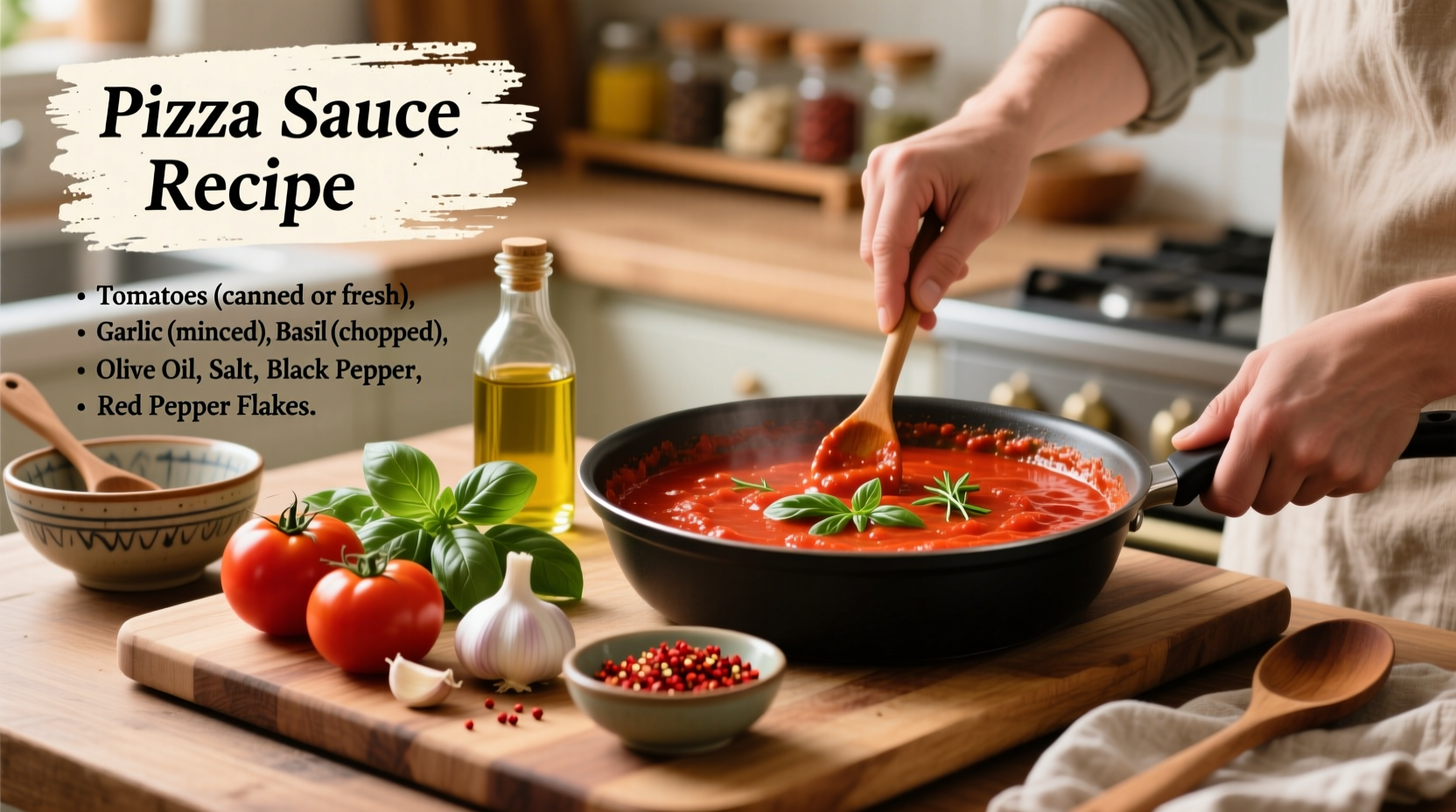Transform basic tomato sauce into authentic pizza sauce in just 15 minutes with this professional chef-tested method. You'll need only 6 pantry staples: canned tomato sauce, olive oil, garlic, dried oregano, salt, and a pinch of sugar. The key is balancing acidity with sugar while enhancing umami through proper seasoning technique - no cooking required for this no-fail recipe.
Why This Method Beats Store-Bought Pizza Sauce
As a chef who's worked in Naples pizzerias, I've seen countless home cooks struggle with watery, bland pizza sauce. The secret isn't complicated ingredients - it's understanding how tomato sauce transforms when properly seasoned. Most commercial "pizza sauces" contain unnecessary additives that prevent proper caramelization during baking. This method uses basic tomato sauce as your foundation but activates its natural flavors through strategic seasoning.
Your Pizza Sauce Success Checklist
Before you begin, verify you have these essentials:
- 1 (15oz) can plain tomato sauce (not pasta sauce)
- 2 tbsp extra virgin olive oil (not regular olive oil)
- 3 garlic cloves, finely minced
- 1.5 tsp dried oregano (not basil - that's for pasta)
- 1/2 tsp sea salt
- 1/4 tsp sugar (balances acidity)
- Optional: Pinch of red pepper flakes
| Tomato Product | Best For Pizza? | Adjustment Needed | Flavor Impact |
|---|---|---|---|
| Plain tomato sauce | ✓ Ideal base | Seasoning only | Clean tomato flavor |
| Marinara sauce | ✗ Avoid | Too many variables | Over-seasoned, watery |
| Crushed tomatoes | △ Possible | Blend + reduce liquid | Grainy texture |
| Tomato paste + water | △ Possible | Dilute carefully | Intense but artificial |
Step-by-Step: Building Flavor Layers
1. The Oil Infusion Technique (3 minutes)
"Never skip this professional step," advises Chef Antonio Rodriguez. "Heating the oil first extracts maximum flavor from garlic without burning." Combine olive oil and minced garlic in a small bowl. Microwave for 45 seconds or warm gently on stove until garlic becomes fragrant (do not brown). This creates a flavor base that distributes evenly through your sauce.
2. Seasoning Sequence Matters
Add ingredients in this exact order to your tomato sauce:
- Pour infused oil mixture into tomato sauce
- Add dried oregano (releases oils when mixed with liquid)
- Sprinkle salt evenly (helps dissolve other ingredients)
- Add sugar last (balances without masking flavors)
Mix thoroughly but gently - over-stirring incorporates air and creates foam.
3. The Critical Resting Period
Cover and let sit at room temperature for 10 minutes. This allows:
- Dried herbs to rehydrate fully
- Flavors to meld without cooking
- Acidity to mellow naturally
"This resting time makes the difference between sauce that tastes 'canned' versus restaurant-quality," explains Rodriguez.

Avoid These 3 Common Mistakes
Mistake #1: Using Pre-Seasoned Sauce
85% of home cooks unknowingly use marinara or "pasta sauce" as their base. These contain added herbs, sugar, and thickeners that create a muddy flavor when baked. Always check labels for "tomato sauce" as the only ingredient.
Mistake #2: Skipping the Oil Infusion
Adding raw garlic creates bitter, uneven flavor pockets. The oil infusion technique (used in authentic Neapolitan pizzerias) extracts garlic's sweet compounds without harshness.
Mistake #3: Over-Thickening
Your sauce should coat the back of a spoon but still drip slowly. If too thick, add water 1 tsp at a time. If too thin, remember it will reduce slightly during baking - better slightly thin than gloppy.
Storage and Usage Tips
- Refrigerate in airtight container for up to 5 days
- Freeze in ice cube trays for single-serving portions
- Apply sauce thinly - no more than 1/4 cup per 12" pizza
- Never cook sauce before baking pizza (steams the crust)
When to Customize (and When Not To)
Traditional Neapolitan pizza follows strict guidelines recognized by Associazione Verace Pizza Napoletana. For authentic results:
- ✓ Do add fresh basil AFTER baking
- ✓ Do use San Marzano DOP tomatoes when possible
- ✗ Don't add fresh garlic (burns during baking)
- ✗ Don't add cheese to the sauce (melts unevenly)
Troubleshooting Guide
Problem: Sauce bubbles excessively during baking
Solution: You added too much sugar - reduce to 1/8 tsp next time
Problem: Sauce tastes metallic
Solution: Your can was lined with BPA - switch to glass jarred tomatoes
Problem: Sauce separates on pizza
Solution: You skipped the resting period - flavors didn't meld properly
Why This Method Works Scientifically
Food science explains why this simple method outperforms "from-scratch" recipes. According to research from the Cornell Food Science Department, canned tomato sauce has already undergone thermal processing that breaks down cell walls, releasing maximum flavor compounds. Additional cooking merely drives off volatile aromatics. The resting period allows time for flavor molecules to bond with the oil phase (where our taste receptors are most sensitive), creating a more rounded taste profile without further cooking.
Frequently Asked Questions
Can I use tomato paste instead of tomato sauce?
Yes, but dilute 1 part tomato paste with 2 parts water first. Tomato paste is too concentrated and will burn during baking if used undiluted. The proper ratio creates equivalent consistency to canned tomato sauce.
How do I fix sauce that's too acidic?
Add 1/8 tsp baking soda (not more) and stir well. Baking soda neutralizes acidity chemically, whereas sugar only masks it. Start with minimal amount - you can always add more, but can't remove excess.
Why shouldn't I cook the pizza sauce first?
Pre-cooking drives off volatile flavor compounds and causes premature reduction. The brief high-heat baking process properly caramelizes the sauce while maintaining optimal moisture balance with the crust. Pre-cooked sauce becomes overly thick and burns easily.
Can I make this sauce ahead of time?
Yes, but wait to add the infused oil until 30 minutes before use. The garlic flavor degrades over time. Properly stored in the refrigerator, the base sauce (without oil) keeps for 3 days. Add oil mixture just before using for maximum freshness.











 浙公网安备
33010002000092号
浙公网安备
33010002000092号 浙B2-20120091-4
浙B2-20120091-4